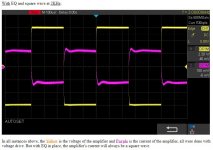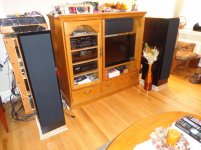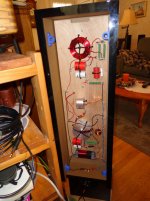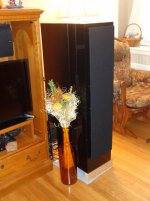The quick or the deadI know, because I bought the last ten they had for a friend.
Greetings from Copenhagen, Denmark.
Waveguide MK 5 same as MK6
Hi,
Three years ago i ordered all the parts for them MK5 but life got in the way, so now i wonder if the MK 5 and MK& is the sahe, same machining and such?
it wouldnt bee too fub ordering new aluminium as aluminium cists pretty much im seden.
Please reply ad don as possible asthe speakers are beung buikt at christmas and the WGs need to br built before that.
Thankyou for your help, best wiahed!!
Hi,
Three years ago i ordered all the parts for them MK5 but life got in the way, so now i wonder if the MK 5 and MK& is the sahe, same machining and such?
it wouldnt bee too fub ordering new aluminium as aluminium cists pretty much im seden.
Please reply ad don as possible asthe speakers are beung buikt at christmas and the WGs need to br built before that.
Thankyou for your help, best wiahed!!
Hello !
Have just found this on the forum part diy, and can see that the ambitions have been high, and thoughtful, congratulations ...
Although I have not had the opportunity to listen to them yet, I see that it seems wise conclusions that have been drawn, well done...
Speaker design is a really complex subject to understand, since speakers are not simple transmission links such as amplifier is.
The speaker should communicate with the human hearing through the room in multiple angles,
which makes it for us who create these speakers to know how to proceed a challange, i will say, many years... how should the frequency response of the loudspeaker look like ? I know that it should not be flat for stereo reproduction, the response has to roll down towards higher frequencies, and even up for some frequencies.
How to construct a good speaker I think one should think like this:
- What is sound and special form music?
- How is music (and other sounds) encoded into phonograms?
- How does the speaker physics work?
- What are the limitations of the stereo system?
- How do different rooms affect?
- How does our hearing (outer, middle and inner ear and brain) work?
- How does the brain decode the sound fields it is exposed to through the hearing?
When you can answer all these (7) small questions, the question is how a speaker should dimensioned right trivial, not to say - already answered.
PS. To get knowledge about each subquestion above takes a few years if one is talented, if you not, it takes additional time, but most speaker builders start at the wrong end.
PPS. I Have made speakers since 1978, so i know the difficulties, the more one knows the more the issues tend to grow, and also the complexity.
Regards Lars
Have just found this on the forum part diy, and can see that the ambitions have been high, and thoughtful, congratulations ...
Although I have not had the opportunity to listen to them yet, I see that it seems wise conclusions that have been drawn, well done...
Speaker design is a really complex subject to understand, since speakers are not simple transmission links such as amplifier is.
The speaker should communicate with the human hearing through the room in multiple angles,
which makes it for us who create these speakers to know how to proceed a challange, i will say, many years... how should the frequency response of the loudspeaker look like ? I know that it should not be flat for stereo reproduction, the response has to roll down towards higher frequencies, and even up for some frequencies.
How to construct a good speaker I think one should think like this:
- What is sound and special form music?
- How is music (and other sounds) encoded into phonograms?
- How does the speaker physics work?
- What are the limitations of the stereo system?
- How do different rooms affect?
- How does our hearing (outer, middle and inner ear and brain) work?
- How does the brain decode the sound fields it is exposed to through the hearing?
When you can answer all these (7) small questions, the question is how a speaker should dimensioned right trivial, not to say - already answered.
PS. To get knowledge about each subquestion above takes a few years if one is talented, if you not, it takes additional time, but most speaker builders start at the wrong end.
PPS. I Have made speakers since 1978, so i know the difficulties, the more one knows the more the issues tend to grow, and also the complexity.
Regards Lars
Last edited:
Folks:
I have been derelict in writing up my experience building the Elsinore loudspeakers. It’s time I stopped procrastinating.
I began discussing the idea of a speaker project almost 5 years ago with a friend who has, on several occasions, “piggy-backed” on my audio projects. We’ve built Gainclones, Aleph P 1.7 preamplifiers and FirstWatt F5 Turbos together. Joe loves music but doesn’t sling solder and needs a lot of help on each project. But one of the things that Joe brings to the table is a local network, and when I proposed building Elsinores he informed me that he knew the owner of a high-end furniture manufacturing business not more than 40 minutes from my home. Since I have no woodworking experience or equipment, my friend’s friend became integral to our plans.
The factory owner agreed to a meeting fairly quickly. We sat down in a conference room at his factory (an amazing place – enormous by any rational standard and equipped with state of the art everything) and I laid out for him the Elsinore design, including a series of modifications I proposed making to the cabinets (more on the mods to come). The factory owner expressed interest – he is a music lover and liked the idea of building the cabinets, in return for which I would do all of the fit-out work. However, he wasn’t convinced that I was anything more than a crackpot, so I invited him to my home to listen to music and to discuss the project further. He agreed but our play date was delayed – he had a series of medical issues that sidelined him for about 1.5 years. When he finally came to my house he announced he only had 45 minutes to spare. My basement system at the time consisted of a Maplenoll Apollo turntable with a Lyra Lydian phono cartridge, a diy Pearl / Ono phono stage (a group buy project), a diy music server (running Daphile), the Aleph 1.7 preamp, F5 Turbo V3 mono-blocks and Egglestonworks Andra loudspeakers. The system sounds pretty good. Three and a half hours after he arrived, the factory owner declared he was in on the project, told me to work with his engineer to develop the CAD drawings and that he’d commit to building three pairs of the cabinets. Joe and I were finally on our way!
The engineer was easy to get along with. I supplied Joe Rasmussen’s cabinet drawings as a starting point. We made a few changes to the cabinet’s design, including inserting neodymium magnets in the front panel to hold metal grilles in place, threaded inserts in the bottom of the speaker for adjustable feet and adding a removable crossover panel and an extension off the back of the speaker to house the crossover. The cabinets were to be made primarily with HDF (a few pieces were MDF) and a piano black veneer was selected for each pair. None of the internal dimensions or panel widths of Joe Rasmussen’s cabinet design were changed, but the engineer had a full schedule and designing the cabinet took another year.
I began obsessing about the BOM early in the project, trying to decide which crossover components, wire and other parts to buy. The Elsinore thread was very helpful, as was trolling around on the ‘web. Weighing the performance vs price value of components is tough enough when you know what you’re doing, but when you’re as inexperienced as I was/am in speaker building there’s a lot to consider. In retrospect, I am pleased to report that my time was well spent.
Around the time we were finally ready to go into production the factory got really busy and our small, boutique project had to be “temporarily” shelved. Then there was yet another lengthy delay while the factory owner underwent another series of medical procedures; he was too consumed with recovering from his surgeries and managing his business remotely to entertain our request to slip the cabinet building into the production schedule. Finally, in the early summer of 2018 the factory owner notified Joe and me that he was sourcing the materials needed to build the cabinets. I mentioned this project to another couple of friends and one (Dave Price, known as “schubert”, a member here) expressed interest in joining the group buy and build. The factory owner agreed to build a fourth pair of cabinets and by early August the cabinets were finished.
I then ordered the parts for four pairs of Elsinores. The deal was this: the factory owner supplied the cabinets and the rest of us bought the rest of the parts needed to finish the speakers. Joe, Dave and I split the cost of the components for the factory owner’s pair of Elsinores. It turns out that if you’re buying that many parts, some of the larger suppliers will offer attractive discounts (our order with Madisound, for example, exceeded $3,500 and with a little encouragement they offered a 30% discount).
Joe and I carted the four pairs of cabinets from the factory to my living room in mid-August 2018. Dave and I worked together on the crossover layout. Joe, Dave and I then spent about a week fitting out our Elsinores. My hat’s off to the pros out there who have scratch-built Elsinores; if you’re not building cabinets, assembling Elsinores is time-consuming but pretty easy. For everyone else, it’s clearly a lot of work. A few photos are attached.
So how do they sound? Over the past 6 or 7 months, about 20 people have auditioned the Elsinores in my basement listening room. A couple were diyAudio members (Dave included), two are semi-professional musicians and the rest included friends, neighbors and family. Everyone had a chance to compare the Elsinores with my Egglestonworks Andras and the nearly-unanimous assessment was that the Elsinores were the superior loudspeaker. The only person who was unsure was me, mostly because I thought it was hubris to believe I could build something better than those Andras. But I’m slowly becoming convinced.
What I’ve long loved about the Egglestonworks Andras is their effortlessness. The Andras are never fatiguing; they always sound like they’re comfortably striding along, easily making music. They have a very natural mid-range and over the past 18 years or so I’ve come to really love them. But the Elsinores are better: the low end is a little more coherent, they seem to be an easier load on my amplifiers (they are certainly a little more efficient) and their tonal balance is incredibly engaging. Nothing too forward, no stridency, beautifully balanced, very engaging. I cannot tell you how pleased I am with these new speakers. I doubt I will ever be able to fully express my appreciation to Joe Rasmussen, whose brilliance appears to be matched by his extraordinary generosity (Joe, if you ever find yourself in the Philadelphia, Pennsylvania, USA region, you have a place to stay and a great bottle of wine waiting for you).
I could not audition the Elsinores before committing to building them, and Joe, Dave and I took a big leap of faith. That leap paid off in spades. But if you are considering undertaking this project, live anywhere close to me and would like to listen to the Elsinores first, reach out. Auditioners are invited.
Highly recommended.
And before anyone asks, no, the factory owner saw this project as a one-off and is not interested in further boutique speaker builds. He has a business to run and he already has his new speakers.
Regards,
Scott
I have been derelict in writing up my experience building the Elsinore loudspeakers. It’s time I stopped procrastinating.
I began discussing the idea of a speaker project almost 5 years ago with a friend who has, on several occasions, “piggy-backed” on my audio projects. We’ve built Gainclones, Aleph P 1.7 preamplifiers and FirstWatt F5 Turbos together. Joe loves music but doesn’t sling solder and needs a lot of help on each project. But one of the things that Joe brings to the table is a local network, and when I proposed building Elsinores he informed me that he knew the owner of a high-end furniture manufacturing business not more than 40 minutes from my home. Since I have no woodworking experience or equipment, my friend’s friend became integral to our plans.
The factory owner agreed to a meeting fairly quickly. We sat down in a conference room at his factory (an amazing place – enormous by any rational standard and equipped with state of the art everything) and I laid out for him the Elsinore design, including a series of modifications I proposed making to the cabinets (more on the mods to come). The factory owner expressed interest – he is a music lover and liked the idea of building the cabinets, in return for which I would do all of the fit-out work. However, he wasn’t convinced that I was anything more than a crackpot, so I invited him to my home to listen to music and to discuss the project further. He agreed but our play date was delayed – he had a series of medical issues that sidelined him for about 1.5 years. When he finally came to my house he announced he only had 45 minutes to spare. My basement system at the time consisted of a Maplenoll Apollo turntable with a Lyra Lydian phono cartridge, a diy Pearl / Ono phono stage (a group buy project), a diy music server (running Daphile), the Aleph 1.7 preamp, F5 Turbo V3 mono-blocks and Egglestonworks Andra loudspeakers. The system sounds pretty good. Three and a half hours after he arrived, the factory owner declared he was in on the project, told me to work with his engineer to develop the CAD drawings and that he’d commit to building three pairs of the cabinets. Joe and I were finally on our way!
The engineer was easy to get along with. I supplied Joe Rasmussen’s cabinet drawings as a starting point. We made a few changes to the cabinet’s design, including inserting neodymium magnets in the front panel to hold metal grilles in place, threaded inserts in the bottom of the speaker for adjustable feet and adding a removable crossover panel and an extension off the back of the speaker to house the crossover. The cabinets were to be made primarily with HDF (a few pieces were MDF) and a piano black veneer was selected for each pair. None of the internal dimensions or panel widths of Joe Rasmussen’s cabinet design were changed, but the engineer had a full schedule and designing the cabinet took another year.
I began obsessing about the BOM early in the project, trying to decide which crossover components, wire and other parts to buy. The Elsinore thread was very helpful, as was trolling around on the ‘web. Weighing the performance vs price value of components is tough enough when you know what you’re doing, but when you’re as inexperienced as I was/am in speaker building there’s a lot to consider. In retrospect, I am pleased to report that my time was well spent.
Around the time we were finally ready to go into production the factory got really busy and our small, boutique project had to be “temporarily” shelved. Then there was yet another lengthy delay while the factory owner underwent another series of medical procedures; he was too consumed with recovering from his surgeries and managing his business remotely to entertain our request to slip the cabinet building into the production schedule. Finally, in the early summer of 2018 the factory owner notified Joe and me that he was sourcing the materials needed to build the cabinets. I mentioned this project to another couple of friends and one (Dave Price, known as “schubert”, a member here) expressed interest in joining the group buy and build. The factory owner agreed to build a fourth pair of cabinets and by early August the cabinets were finished.
I then ordered the parts for four pairs of Elsinores. The deal was this: the factory owner supplied the cabinets and the rest of us bought the rest of the parts needed to finish the speakers. Joe, Dave and I split the cost of the components for the factory owner’s pair of Elsinores. It turns out that if you’re buying that many parts, some of the larger suppliers will offer attractive discounts (our order with Madisound, for example, exceeded $3,500 and with a little encouragement they offered a 30% discount).
Joe and I carted the four pairs of cabinets from the factory to my living room in mid-August 2018. Dave and I worked together on the crossover layout. Joe, Dave and I then spent about a week fitting out our Elsinores. My hat’s off to the pros out there who have scratch-built Elsinores; if you’re not building cabinets, assembling Elsinores is time-consuming but pretty easy. For everyone else, it’s clearly a lot of work. A few photos are attached.
So how do they sound? Over the past 6 or 7 months, about 20 people have auditioned the Elsinores in my basement listening room. A couple were diyAudio members (Dave included), two are semi-professional musicians and the rest included friends, neighbors and family. Everyone had a chance to compare the Elsinores with my Egglestonworks Andras and the nearly-unanimous assessment was that the Elsinores were the superior loudspeaker. The only person who was unsure was me, mostly because I thought it was hubris to believe I could build something better than those Andras. But I’m slowly becoming convinced.
What I’ve long loved about the Egglestonworks Andras is their effortlessness. The Andras are never fatiguing; they always sound like they’re comfortably striding along, easily making music. They have a very natural mid-range and over the past 18 years or so I’ve come to really love them. But the Elsinores are better: the low end is a little more coherent, they seem to be an easier load on my amplifiers (they are certainly a little more efficient) and their tonal balance is incredibly engaging. Nothing too forward, no stridency, beautifully balanced, very engaging. I cannot tell you how pleased I am with these new speakers. I doubt I will ever be able to fully express my appreciation to Joe Rasmussen, whose brilliance appears to be matched by his extraordinary generosity (Joe, if you ever find yourself in the Philadelphia, Pennsylvania, USA region, you have a place to stay and a great bottle of wine waiting for you).
I could not audition the Elsinores before committing to building them, and Joe, Dave and I took a big leap of faith. That leap paid off in spades. But if you are considering undertaking this project, live anywhere close to me and would like to listen to the Elsinores first, reach out. Auditioners are invited.
Highly recommended.
And before anyone asks, no, the factory owner saw this project as a one-off and is not interested in further boutique speaker builds. He has a business to run and he already has his new speakers.
Regards,
Scott
Attachments
-
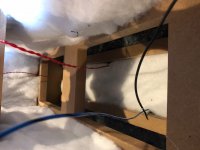 Damping_1.jpg463.4 KB · Views: 1,601
Damping_1.jpg463.4 KB · Views: 1,601 -
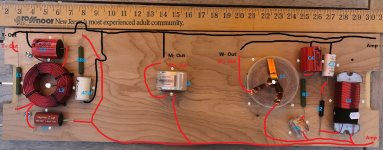 Hybrid (D & S) Crossover Layout v2-3.jpg369.9 KB · Views: 1,570
Hybrid (D & S) Crossover Layout v2-3.jpg369.9 KB · Views: 1,570 -
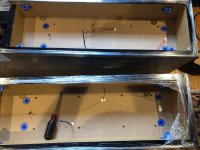 Wiring Harnesses (pair).jpg769 KB · Views: 1,575
Wiring Harnesses (pair).jpg769 KB · Views: 1,575 -
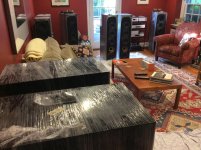 Living Room of Elsinores.jpg591.6 KB · Views: 1,574
Living Room of Elsinores.jpg591.6 KB · Views: 1,574 -
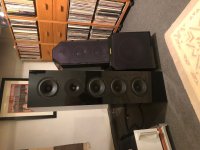 Andra & Elsinore.jpg636.8 KB · Views: 1,590
Andra & Elsinore.jpg636.8 KB · Views: 1,590 -
Elsinore CAD and Related Files.zip787.6 KB · Views: 274
-
Elsinore BOM Final (diyAudio upload).zip10.2 KB · Views: 300
I've got the parts for around a couple of years too... need to start building...!
Just do it - you will kick yourself that you have been missing out. I’ve had mine done for several years and have been thoroughly enjoying them. A most worthwhile audio project.
So how do they sound? Over the past 6 or 7 months, about 20 people have auditioned the Elsinores in my basement listening room. A couple were diyAudio members (Dave included), two are semi-professional musicians and the rest included friends, neighbors and family. Everyone had a chance to compare the Elsinores with my Egglestonworks Andras and the nearly-unanimous assessment was that the Elsinores were the superior loudspeaker. The only person who was unsure was me, mostly because I thought it was hubris to believe I could build something better than those Andras. But I’m slowly becoming convinced.
What I’ve long loved about the Egglestonworks Andras is their effortlessness. The Andras are never fatiguing; they always sound like they’re comfortably striding along, easily making music. They have a very natural mid-range and over the past 18 years or so I’ve come to really love them. But the Elsinores are better: the low end is a little more coherent, they seem to be an easier load on my amplifiers (they are certainly a little more efficient) and their tonal balance is incredibly engaging. Nothing too forward, no stridency, beautifully balanced, very engaging. I cannot tell you how pleased I am with these new speakers. I doubt I will ever be able to fully express my appreciation to Joe Rasmussen, whose brilliance appears to be matched by his extraordinary generosity (Joe, if you ever find yourself in the Philadelphia, Pennsylvania, USA region, you have a place to stay and a great bottle of wine waiting for you).
Scott
Hi Scott
Pleased with your final success. You mention how the Elsinores are "very engaging" and "no stridency" etc. While this this thread has been going since February 2007 (twelve years this month, anniversary on the 26th), it has mostly been about building and everybody helping each other out.
But I have been keeping some of the more extremely technical aspects of the design to a minimum. But since you have now compared them to the Eggleston Andras that costs a number of tens of thousands of dollars, and the cost of buying high-end speakers have gone up-and-up since they came out - perhaps a word or two plus an intriguing measurement. I also recall that they made Stereophile Class A list and so on. The Andras have an extensive philosophy behind them, as does all serious speakers. They will claim serious development time, probably an extreme number of hours.
So how can a DIY speaker compete and perhaps even better such a highly technically developed loudspeaker like the E-A? Just a bit of luck, perhaps? No, here we are talking thousands of hours and I am not exaggerating. But everything in life should not always be about $$$.
The Elsinore Mk6 also has a serious and highly technically developed philosophy behind them.
What is the key to the Elsinores? It down to something that we can call "current management."
Basically all commercial speakers are, bluntly speaking, based on the "voltage" model and the Elsinores are definitely based on what happens to the "current" and not just the voltage - it is about priority and how it behaves and affects, not just the speaker, but also the amplifier. It has already been proved by measurements that an amplifier can have two different distortion profiles at the same time (unless the load is purely resistive). In these times this can be a dangerous thing to say, but we have the measurements and they have been done by more than one person. The question is, which profile does the speaker produce, the voltage or the current? The facts say that it is the current.
One has be very careful these says to make any claim on an online forum, or you are possibly opening yourself up to trolling, especially if the "new" word is mentioned. But the Elsinores does something when it comes to the current (and no, as somebody accused me of saying, the voltage is not the bad guy), the Elsinores draws the same current at all frequencies.
Something remarkable happens when you do this, the output impedance effectively becomes cancelled out. It does not matter if you have a solid state amp with an output impedance of 0.001 Ohm (and claiming a silly damping factor of near 10.000) or if it is a single-ended tube amplifier that has 5 Ohm and sometimes higher. Indeed the Elsinores will work perfectly with a pure current source amplifier with a theoretical infinite output impedance. I have an amplifier here that has an output impedance of 270 Ohm and no problem.
But of course, it is what it does to the sound that really matters. Clean up the current and you hear it. No golden ears required. But this is about current EQ, that is equalising the current of the amplifier and while the Elsinores takes this to an extreme degree, there are now speaker designs that use crude forms of current EQ and I could mention names.
What makes a cone move and make sound? Not the voltage that appears across its terminals, but the current that goes through the voice coil, from one terminal to the other.
The equation that created this Force is F=BLI, where F is the force, the B is the magnetic side and the L is the coil length - and this is multiplied by "i" which is the current that is flowing.
There is no voltage in that equation and hence voltage has no direct role because it has no quantitative value.
But thinking voltage is easy, thinking current is like thinking another language, it is like comparing English with Chinese - it takes a lot of effort to wrap one's mind around it. Voltage is intuitive, understanding current is not. It tricks you up.
Take a look at the below posted attachment, note that Yellow is the voltage of the amplifier and that it is a square wave. This is an actual measurement. Using a tiny current sense resistor we were able to see what the amplifier does on the current side. Note that it too is producing a square wave. The current phase angle is almost zero from DC to 100KHz+, that square wave is produced no matter what amplifier is used. Current can be reactive or non-reactive.
No amplifier ever designed can produce reactive current into the Elsinores.
Maths and measurements are being gathered, several physicists and scientists plus other significant persons are now involved, everything is being carefully documented, so it can be repeated by anybody in the future. This is effectively a very comprehensive peer review.
So I hope that gives a little bit of insight, that behind the Elsinores lies thinking that is not only very advanced, but it is also a vehicle for development that has brought real benefits to the art.
Take a look at that attachment below, it is not a common measurement, and we have more like them.
Cheers, Joe
Attachments
Last edited:
I also find Elsinores very forgiving of the amp choice. I have a bunch of class A Pass designs but even a plain vanilla amp from the store sounds decent with these. Mine are for sale now however. I just have too many speakers and have to make some room.
So if anyone is coming through Windsor(Detroit) area they can have them for say US$1,600, cherry veneered and with solid mahogany inserts on baffle corners. one has a crack in the veneer on the back but that never bothered me; (except for the fact that I made it when hitting a wooden dowel pin too hard from the inside out so it poked into the veneer )
)
you can see them here before finished.
https://www.diyaudio.com/forums/multi-way/97043-elsinore-project-thread-161.html#post3618366
A truly great design Joe. probably as good as it gets with a vented box. Driven with BA-3b amps the bass is so tight one would never think the box was vented . They like to be toed in though. Thanks again.
. They like to be toed in though. Thanks again.
So if anyone is coming through Windsor(Detroit) area they can have them for say US$1,600, cherry veneered and with solid mahogany inserts on baffle corners. one has a crack in the veneer on the back but that never bothered me; (except for the fact that I made it when hitting a wooden dowel pin too hard from the inside out so it poked into the veneer
you can see them here before finished.
https://www.diyaudio.com/forums/multi-way/97043-elsinore-project-thread-161.html#post3618366
A truly great design Joe. probably as good as it gets with a vented box. Driven with BA-3b amps the bass is so tight one would never think the box was vented
I have been derelict in writing up my experience building the Elsinore loudspeakers.
I was one of the beneficiaries of Scott's hard work, and I'm enjoying my Elsinores immensely. They're everything they are cracked up to be. Thanks, Scott, for including me!
For those interested, the Pass M2 makes an ideal amplifier companion for the Elsinore. There's a special synergy there, in my opinion.
Dave Price
Attachments
They do love a medium power class A amp. I'm using two Monarchy class A SM70 Pro amps in bridging mode. Sublime! Still makes my hair sand up on certain tracks. If you want a reference recording I recommend "Roadhouses and Automobiles" by Chris Jones. It's probably the best recording I've heard. He sounds like he's sitting in your lounge room about three feet behind the Elsinore's.
two Monarchy class A SM70 Pro amps in bridging mode
I was very impressed with the pair i heard (in the end we used 1 channel per amplifier). A while ago… back when we 1st started building Fonkens.
dave
I have been researching my next speaker project, wishing to downsize from my current open-baffle (Basszilla) and horn setups, and have decided to build the Elsinore based on the excellent documentation and feed back of builders. In fact, I just placed an order for the tweeter waveguides, so am semi-committed now.
I noticed that the original Mk6 SB woofers are pretty much non-obtainium in the US now (a couple weeks ago I found 3 left at Madisound and only 1 at Meniscus, not the 8 needed for the project). The Peerless Nomex HDS woofers for the Mk5 build are available at PartsExpress. Also note that the recommended replacement poly-cone SB woofer for Mk6 also appears to be available at Madisound.
Troels Gravenson appears to have a high opinion of the Peerless Nomex driver, particularly together with the same tweeter as used in the Elsinore in his Nomex-164 MkII design.
Therefore, I am struggling with a decision on which version of the Elsinores to build. Has anyone listened to the SB17MFC35-8 in a Mk6 in comparison with coated paper cone version? Concerned about midrange quality more than anything else. Realize they are very close mechanically and electrically and recommended now for Mk6 builds. Obviously there are a number of Mk5 builds with the Nomex woofer, so plenty of experience I can read about. Do the design and performance advancements of the Mk6 with the poly-cone SB woofer outweigh the performance of the Mk5 with the Peerless Nomex driver?
Just trying to understand the trade-offs.
Just to give you a bit of my background, I am an mechanical engineer, musician (recorder player and teacher), listen 95% to classical music, on vinyl as well as digital, and have been building tube amplifiers for the past 20 years, mainly single-ended builds (including an SET GM70 which would be perfect for these speakers, I think). Also recently completed a 25W tube/MOSFET hybrid amp using the Pass BA complementary output boards that turned out much better than I ever expected and would should work well with the Elsinores.
Thanks.
David
I noticed that the original Mk6 SB woofers are pretty much non-obtainium in the US now (a couple weeks ago I found 3 left at Madisound and only 1 at Meniscus, not the 8 needed for the project). The Peerless Nomex HDS woofers for the Mk5 build are available at PartsExpress. Also note that the recommended replacement poly-cone SB woofer for Mk6 also appears to be available at Madisound.
Troels Gravenson appears to have a high opinion of the Peerless Nomex driver, particularly together with the same tweeter as used in the Elsinore in his Nomex-164 MkII design.
Therefore, I am struggling with a decision on which version of the Elsinores to build. Has anyone listened to the SB17MFC35-8 in a Mk6 in comparison with coated paper cone version? Concerned about midrange quality more than anything else. Realize they are very close mechanically and electrically and recommended now for Mk6 builds. Obviously there are a number of Mk5 builds with the Nomex woofer, so plenty of experience I can read about. Do the design and performance advancements of the Mk6 with the poly-cone SB woofer outweigh the performance of the Mk5 with the Peerless Nomex driver?
Just trying to understand the trade-offs.
Just to give you a bit of my background, I am an mechanical engineer, musician (recorder player and teacher), listen 95% to classical music, on vinyl as well as digital, and have been building tube amplifiers for the past 20 years, mainly single-ended builds (including an SET GM70 which would be perfect for these speakers, I think). Also recently completed a 25W tube/MOSFET hybrid amp using the Pass BA complementary output boards that turned out much better than I ever expected and would should work well with the Elsinores.
Thanks.
David
I want to follow-up with a question concerning using a pair of SB17NRXC35-8 for the upper mid-bass drivers combined with a pair of SB17MFC35-8 for the lower drivers. I think I can still get a total of 4 of the original Mk6 drivers, and figured that a slight driver mismatch might be tolerable and help mitigate the small loss of efficiency.
Thanks.
David
Thanks.
David
David:
Good luck with your project! I hope you can find suitable drivers; the Elsinores really are a remarkable loudspeaker system.
Coincidentally, I grew up in Silver Spring. If you decide you want to audition the Elsinores before fully committing, I'm about 2 hours and 10 minutes north of you.
Regards,
Scott
Good luck with your project! I hope you can find suitable drivers; the Elsinores really are a remarkable loudspeaker system.
Coincidentally, I grew up in Silver Spring. If you decide you want to audition the Elsinores before fully committing, I'm about 2 hours and 10 minutes north of you.
Regards,
Scott
- Home
- Loudspeakers
- Multi-Way
- The "Elsinore Project" Thread
